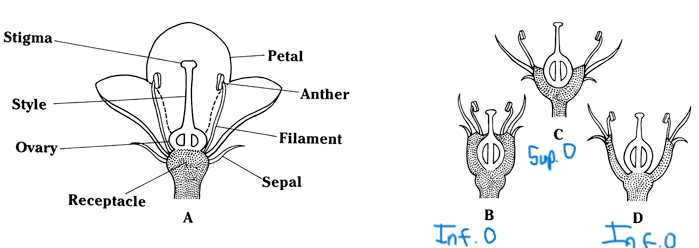BSC226: Seeded Plants: Gymnosperms and Angiosperms
Seeded Plants
General Definitions 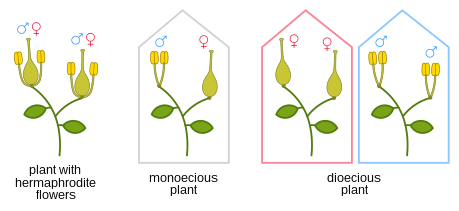
Monoecious: female and male reproductive structures on the same plant
Dioecious: female and male reproductive structures on separate plants
Synoecious: having male and female organs in the same flower or receptacle
Zygomorphic: bilaterally symmetric
Circinate vernation: the unrolling of leaves are plants mature, found in ferns and cycads
Cotleydon: seed leaves
Dichotomous venation: Veins fork by twos extending from a common point forming a “y” pattern fanning put in leaves
Tunica: the organization of the shoot apex consisting of one or more peripheral layers of cells and interior. Tunica layers undergo surface growth (anticlinal divisions)
Reticulate Venatation
Introduction
Arise in the Late Carboniferous period
Gymnosperms
Naked seed
About 1079 species
Angiosperms: seeds inside additional structure
Retention of the megaspore
All seed plants are heterosporous
What is a seed
A fertilized reproductive structure consisting of three parts of a plant life cycle
Mother sporophyte covering/integument (2n)
Nutritive megagametophyte (n) -> at first, the megaspore
Zygote (2n)
In flowering plants, also contains 2 polar nuclei that form an endospore (3n)
Nonferitlzied unit: ovule
Integument: protecting the covering of the seed
Micropyle: little opening in the integument to the megasporangium
Gymnosperm seed:
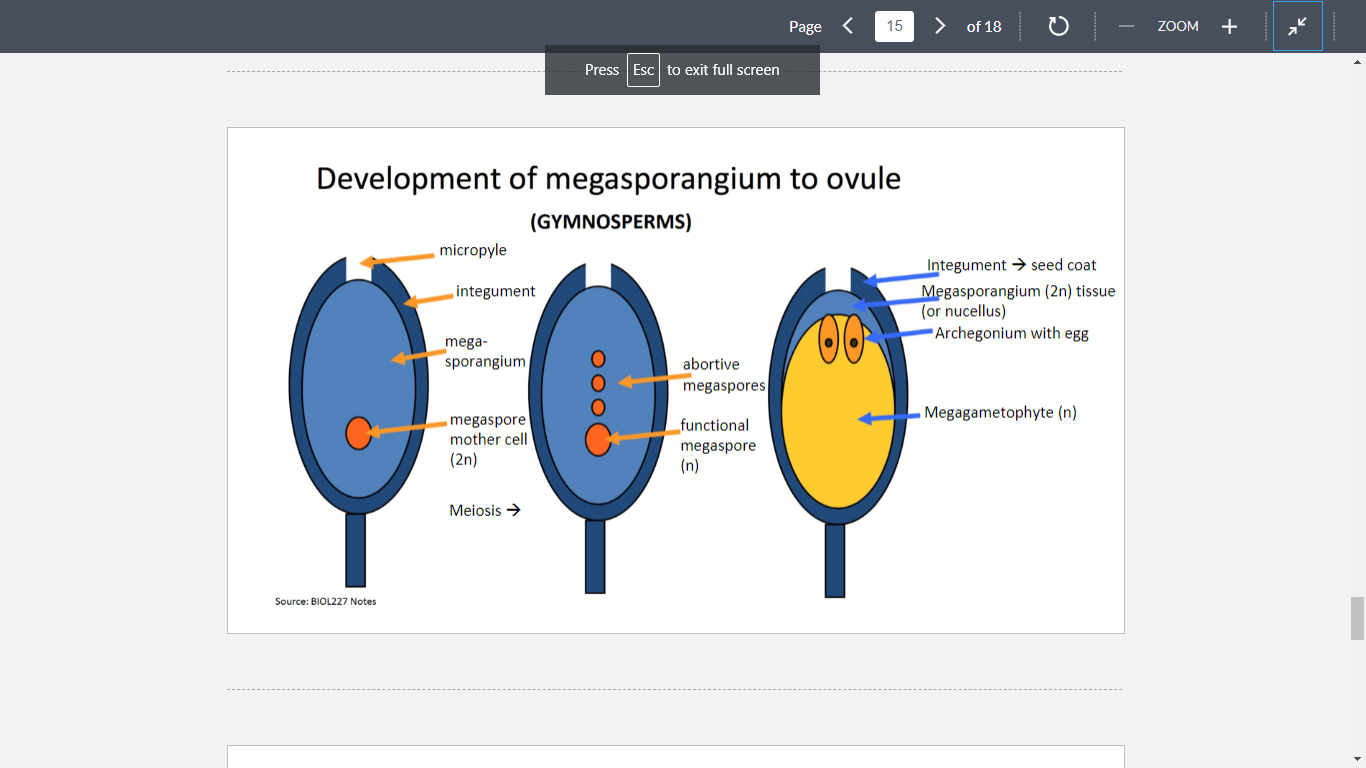
Angiosperm Seed:
Unfertilized megasporangium: called an ovule
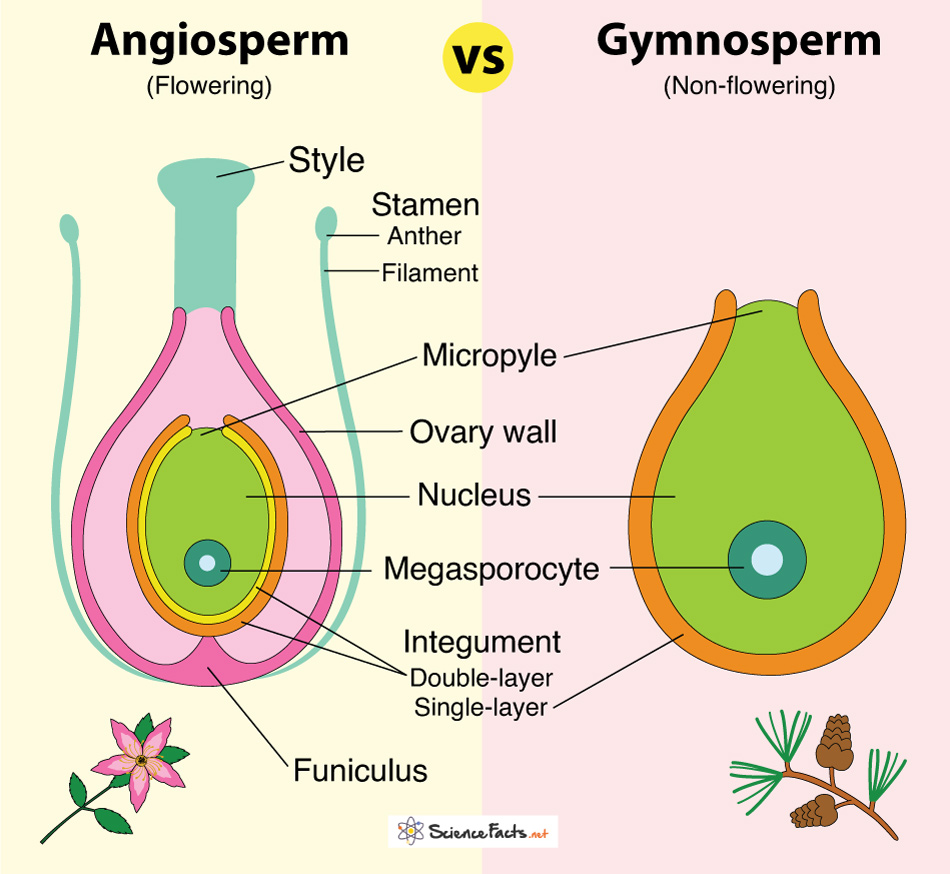
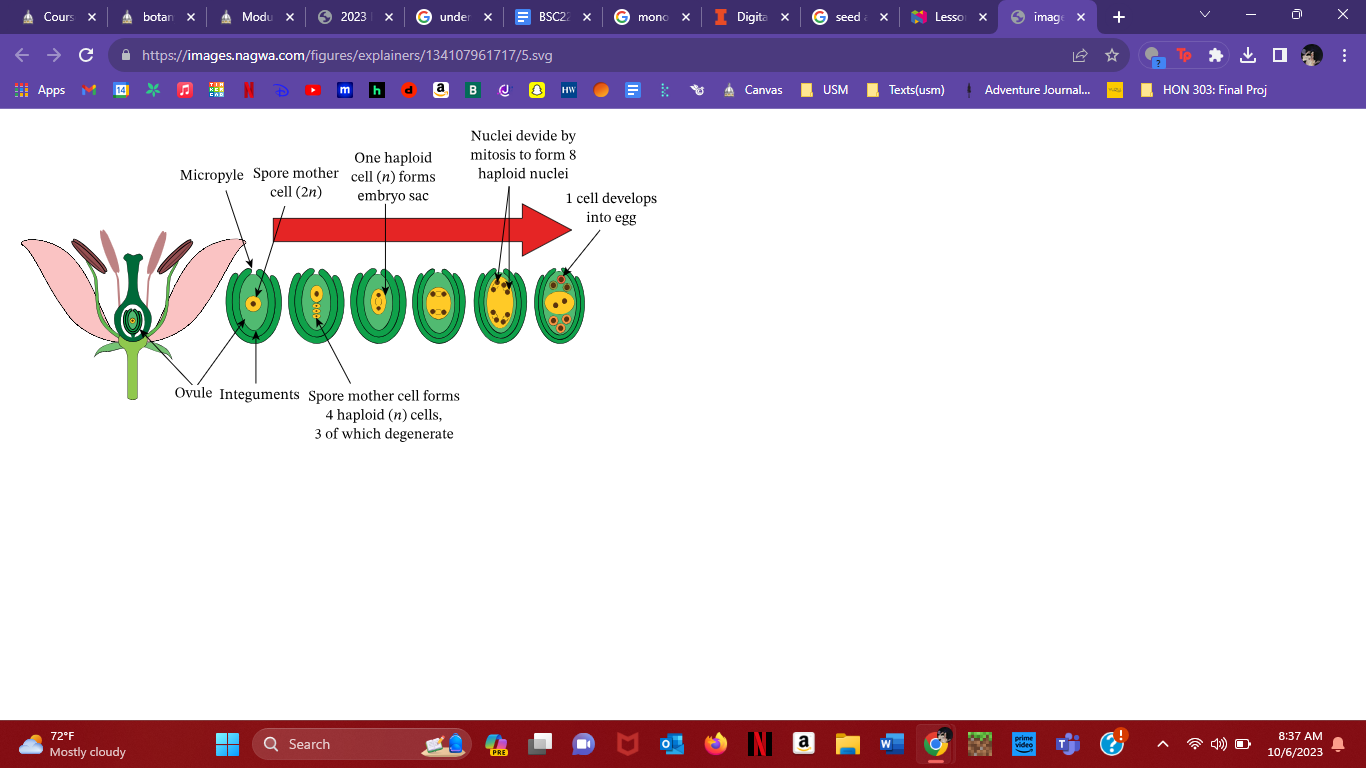
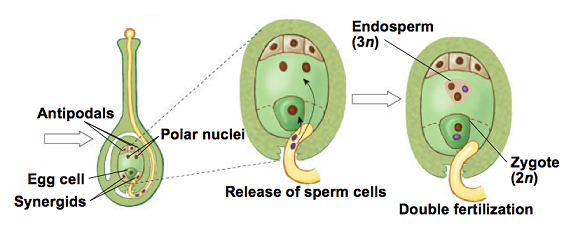
Mother sporophyte covering/integument (2n)
Nutritive megagametophyte (n) -> at first, the megaspore
Zygote (2n)
In flowering plants, also contains 2 polar nuclei that form an endospore (3n) during double fertilization
Double Layer integuments
Gymnosperms
Phylum Cycadophyta
337 species
Common in the Mesozoic period
DIoecious
Pinnately divided leaves w/ circinate vernation
Vascular tissue:
Located in Eustele: separate bundles mostly around the edge
Reproduction:
Located in cones
Female Plants: round cones
Male cones: Long cylindrical cones
Microspores:
Microspore (n)-> microgametophyte(3 cells) begins while grains are still in the microsporangium
monosulcate: pollen with one furrow through which the germinating pollen tube develops
Pollen: (microgametophyte)
Monosulcate
Dispred by insects
Pollen lands on a pollination roplet (exuding from the micropyle)
A spermatogenous cell divides to form 2 multi-flagellated sperm, fertiliztion occurs
Fertilization can take up to 4-6 months
Female gametophyte
2-6 archegonia form at the micropylar end each with a larg egg cell
Pollen tube ruptures in a pollen chamber to release the two sperm which swim into the archegonial chambers
Seeds:
2 cotyledons
Root emergers first from the seed through the micropyle
2 cotyledons remain in the seed
True leaves emerge from the ruptured seed coat
Phylum Ginkgophyta
Many fossil species
Single extant species: Ginkgo biloba
Dioecious
Leaves (sometimes bilobed)
Dichotomous venation
Male sporangia in loose cone structures
Ovules/seeds in stalked pairs
Shoots and Leaves:
Long shoots: with distinct nodes and internodes
Short shoots: spur shoots with short, crowded internodes
Loose wood (secondary growth(
The degree of lobing of the leaf depends on position and hormones
Sperm is flagellated
Pollination occurs before fertilization
Phylum Gnetophyta
Male and female cones associate with one another
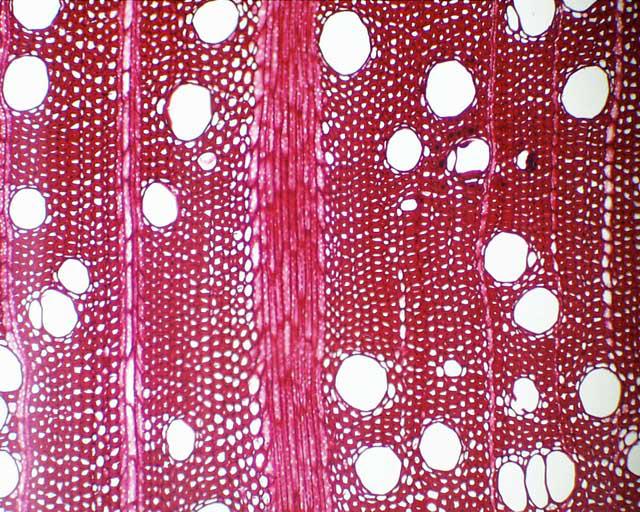
Flower-like cones when both cones are together
Ring of male sporangia at the top of stalk
Vessels present in wood
Vessel: big water transport pipes
Also contain tracheads
Mostly dioecious (few monoecious)
DNA Diadvamntges
Plants copy a lot of chromosomes
Differences can be repeated leading to confusing results and false associations
Genus Ephedra
Source of ephedrine, pseudoephedrine and other stimulats
Leaves are opposite or whorls
Misty dioecious (gew monoecious)
Bracts under microsporangia and megasporangia
Pollen germinates directly onto gametophyte
Pollination and fertilization lasts 10 hours
Genus Gnetum
Leaves opposite, with net like (reticulate) venation
Cone/strobilus divided into conspicuous nodes and internodes
Moropohloigcally similar to angiosperms
Genus Welwitschia
1 species in the Namib Desert of Angola and Namibia
Produces two leaves which grow indefinitely
Leaf veins parallel, connected by small oblique veins
Apical meristem dies early: plant without its head
Dioecious
Cones on branches stalks
Anthophyte Hypothesis
Hypthesis that proposes that gnetophytes are the sister group of Angiosperms
Evidence: (mostly morphological)
Presence of vessels in xylem
Take less energy than trachedis, which use adhesion
Compound nature of both male and female cones with enveloping brats
Net veined leaves
Commonalities in Gnetophytes and flowering plants:
Shoot apical meristems with a protective layer (tunica)
Double fertilization
No archegonia
Vessels in wood
Each megasporangium, surrounded by two parts, could be two integuments
Phylum Confierophyta
Dominant plants in the largest forests of the world (Taiga)
Presence in the Upper Carboniferous
Cedars, Yews, Douglas firs, cypress, firs, jumpers, pines
Woody plants
Leaves-needle like
Some exhibit broader leaves
Mostly monoecious
Reproduction:
Male and Female Sporangia
Microsporangiate: pollen cones
Small
Sporangia below and are paired on a branch
Male Gaemets lack flagella
Megasporangiate (seed) cones
Female cones are above and are paired on a reduced branch with another brat
Seeds are pointed to the inside of the cone
Two brackets per egg
Life Cycle:
Megaspore division to form gametophytes occurs within the sporangia
Oldest individual: Pinus longaeva
bristlecone pine
Tallest individual: Sequoia sempervirens
Coast redwoods
Most VOluminous Individual: Sequoiadendron giganteum
Giant sequoia
Angiosperms
Flowering plants
Rapid appearance in the Cretaceous period
General Characteristics
Flower: male female sporangia arranged together within a single structure subtended by two sterile whorls (sepals and whorls)
Pistil/Fruit: seeds enclosed within a protective structure
Fruit: mature pistils
Vessels
Embryo Sac: reduction of female gametophyte to 7 cells and 8 nucleic
Double Fertilization: one sperm fertilizes egg; the other sperm fertilizes two polar nucleic and forms a 3n nutritive tissue (Endosperm)
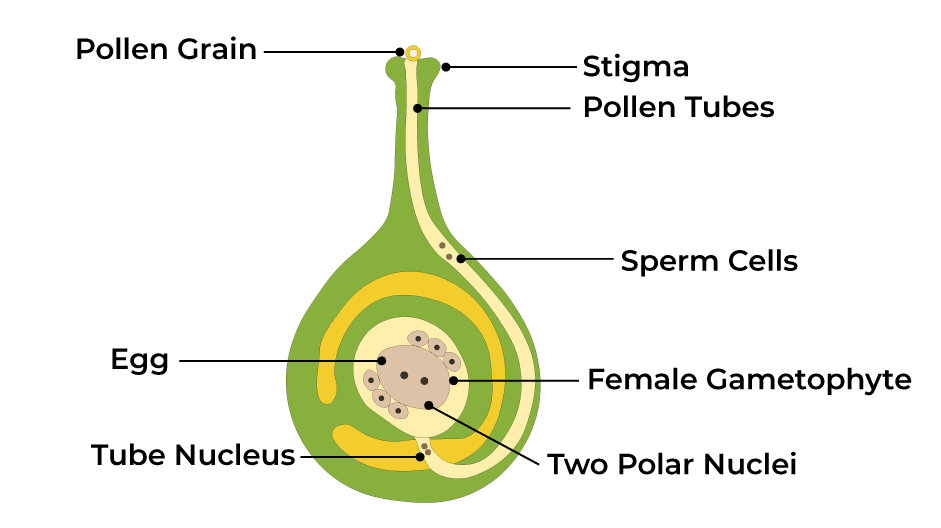
Divides rapidly
Abominable Mystery:
Rapid appearance and divsersification in the Cretaceous (
Plants not have fossilized easily
Perfect (bisexual): majoirty of flowers include both stamens and carpels
Imperfect (unisexual) stamen or carpel is missing
Staimante and carpellate flowers on the same plant: monoecious
Flowers on different plants: dioecious
Three Main groups of Angiosperms
Cotelydon: seed leaf
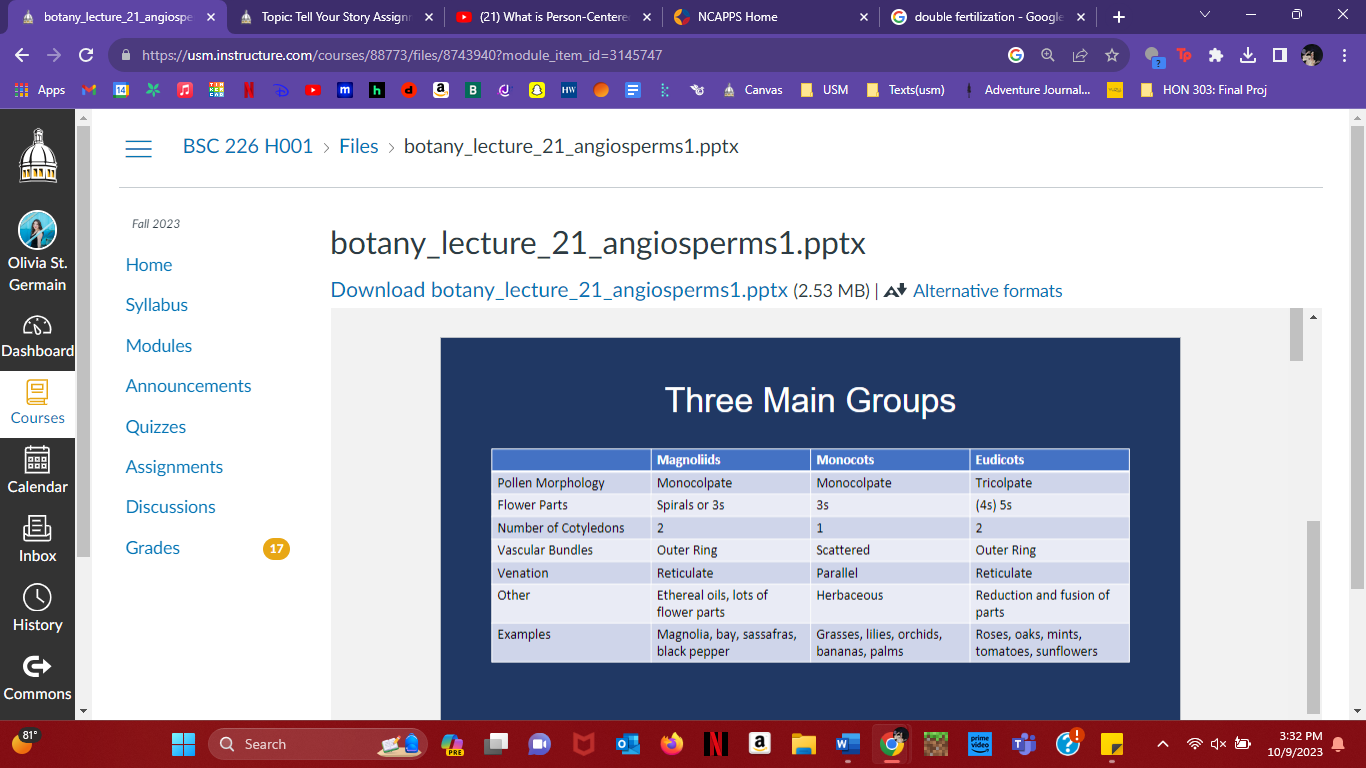
Monocots:
Flowering parts in 3s
# of cotyledons: 1
Benetation: parallel
Scattered vascular bundles
Herbaceous
Pollen morph: monocolplate
Pollen grains that have a single germinal furrow

Eudicots (tricolplate)
# of cotyledons: 2
Flower parts: 4s or 5s
Vascular bundles: outer ring
Venatation: reticulate(netlike)
Smaller flowers and fusing of parts
Pollen: tricolpate
Pollen with three apertures, equally spaced and parallel to the polar axis
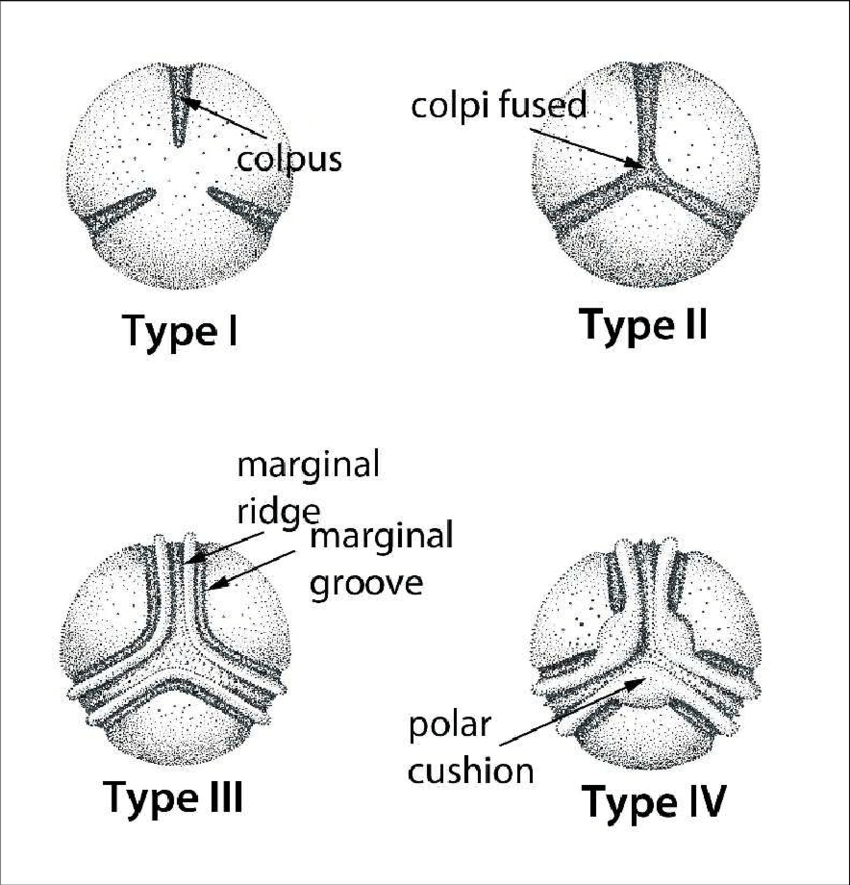
Magnoliids (older plants)
Flower parts: spirals or 3s
# of cotelydons: 2
Vascular bundles: outring
Venatation: reticulate
Has ethereal oils
Shoots and stems
Typically has a tunica (like gnetophytes)
Dicots:
Vascular tissues arranged in eusteles
Eusteles: vascular bundles of phloem and xylem strands with parenchyma cells between bundles
Placed in a ring on the outer edge
Monocots:
Scatted throughout the stem in monocots
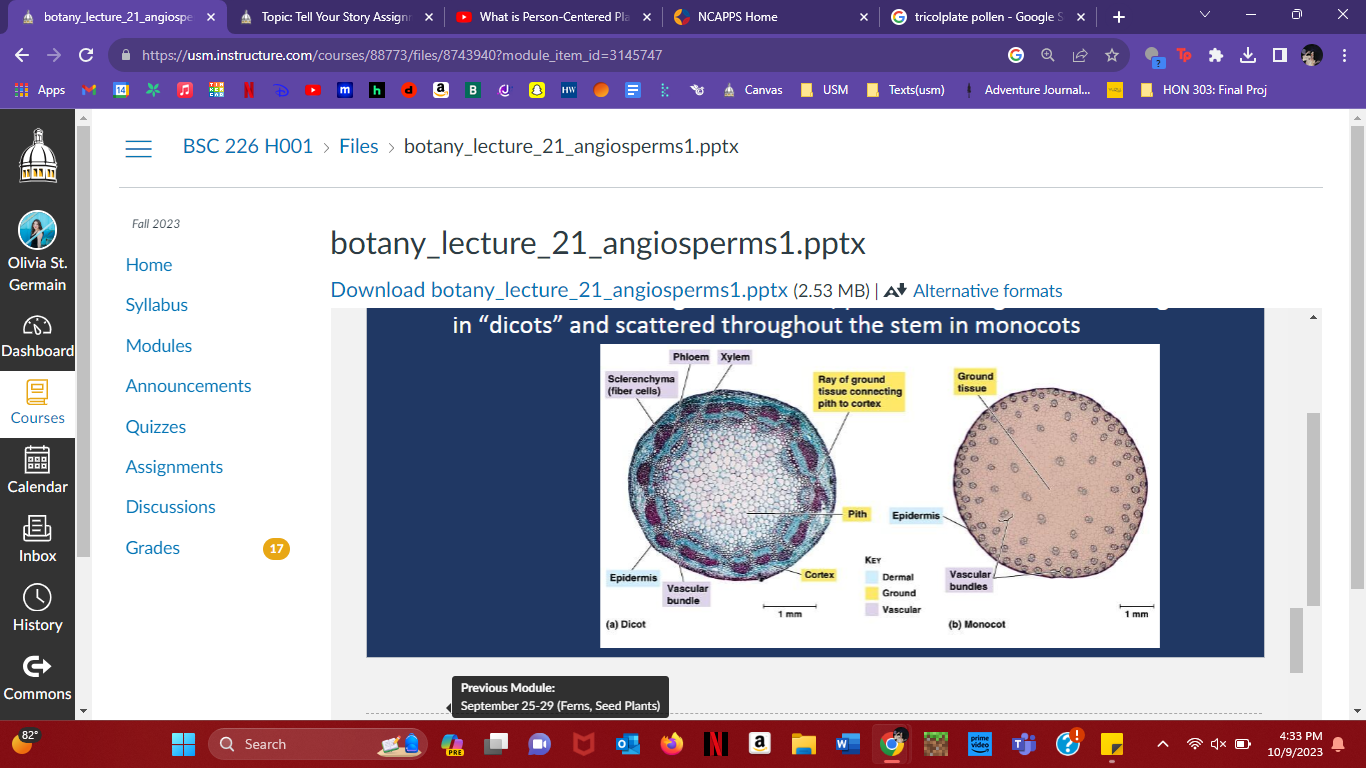
General Structure of angiosperm:

Stamen(microsporangium): anther and filament
4 microsporangia in total
In older (fossil plants) males are held on a petal-like structure instead of a filament called a LAMINA
Life cycle:
Microspores (N)-> division-> 2 pollen cells -> mitosis-> form 2 non flagellated sperm
Monocolplate pollen:
Gymnosperm (not pines), monocots, magnoliids
Tricoplate:
Eudicots
Pistil (megasporangium): stigma, style, ovary
Carpel: female units of symmetry
Pistils that fused together, creating 1 symmetrical pistil
APOCARPOUS:
Multiple free pistils
Cross section Marginal pistils
Many females in 1 flower
Typically found in early plants

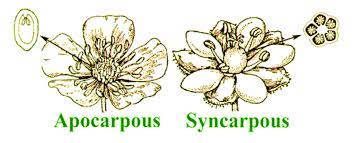
SYNCARPOUS
1 pistil, made of multiple parts
Pistils are fused together
Depends on placement:
Pariental: pistils are found in the side of the wall
Axile: central walls
Free central: attached to a flagpole(middle) inside
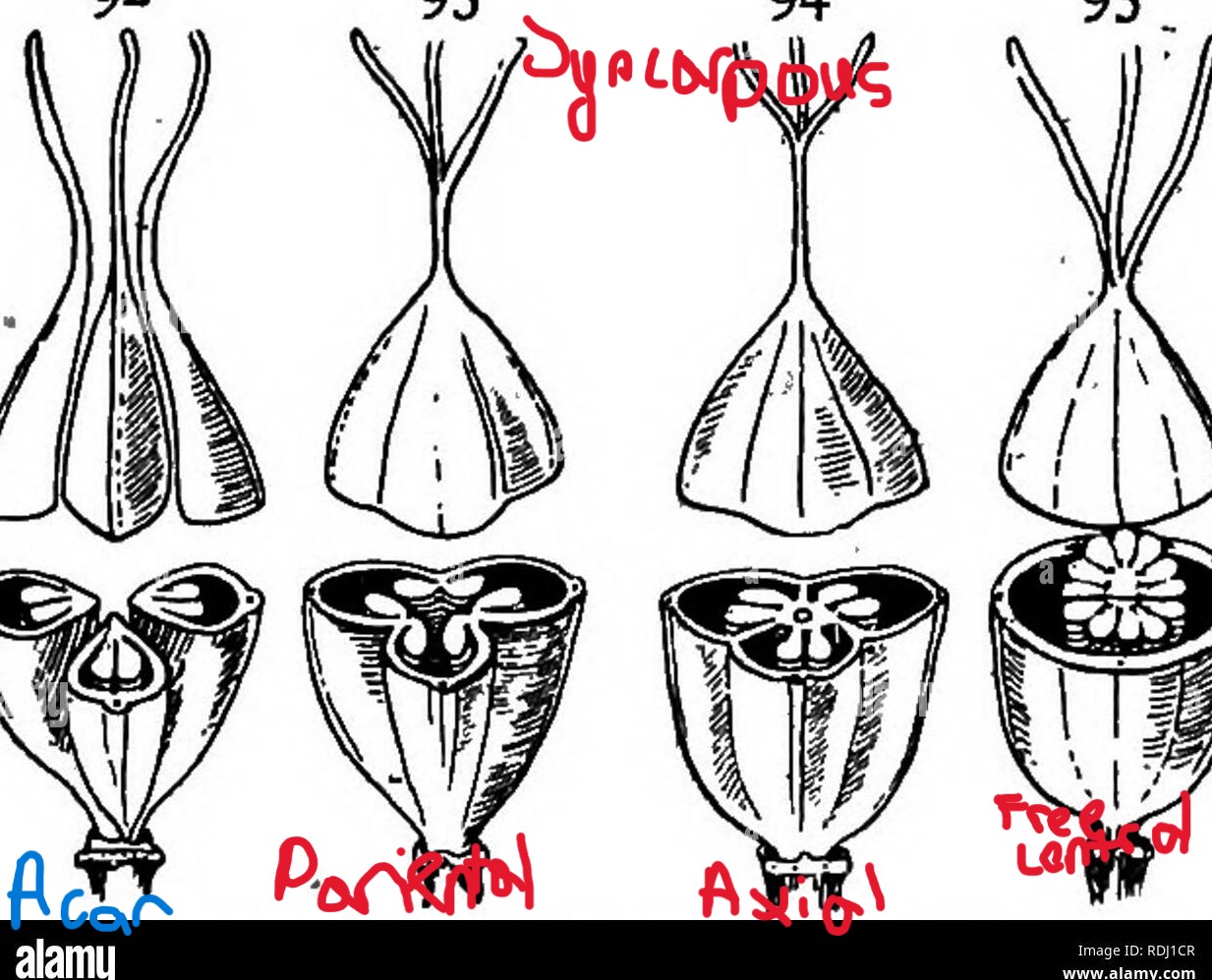
Pistils Evolution:
Began as modified leaves w/ sporangia on leaflets (similar to cycads)
Leaf edges curled inwards and fused_> 3 carpels have fused to form a large chambered ovary
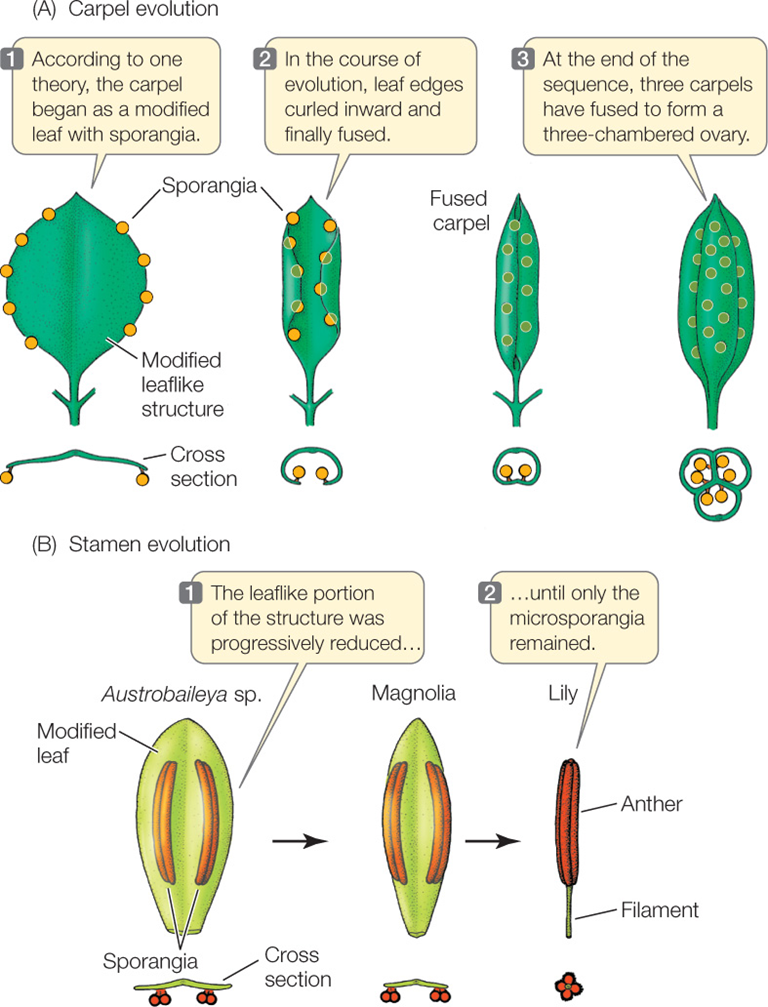
Megasporgangium:
Ovules oriented with the pistils
Two integuments on the megasporangium ovule may be erect or turned back against the funiculus (most common form)
Floral and Ovary Organization:
Ovary Superior: ovary attached to the receptacle above the attachment of other floral parts
Flower hypogynous: sepals, petals, stamens are attached to the receptacle below the ovary
Flower perigynous: sepals, petals and stamen are attached to the margin of a cup-shaped extension of the receptacle (hypanthium)
It appears to be on the ovary
Overy Inferior: an ovary sits below the point of attachment for the other parts of the flower
Ex: bananas, apples. Blueberries
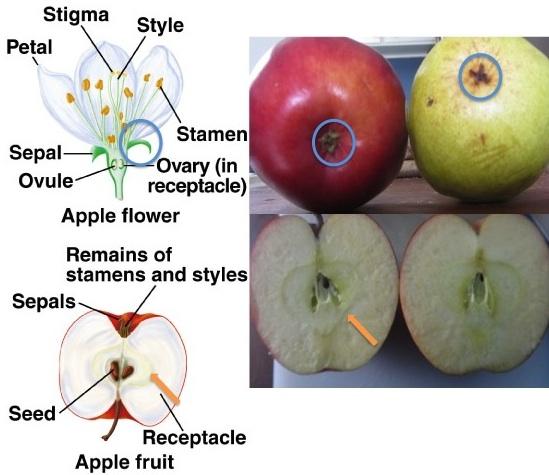
Flower epigynous: sepals, petals, and stamens grow from the top of the ovary
Found in the inferior ovary

Hypanthium: floral cup
Microgametophyte: pollen
Consists of only two cells:
Generative and vegetative cell
Upon germinating on the stigma, the generative cell of the pollen will divide to form two sperm nuclei
Life Cycle of an Angiosperm
Alternation of Generations:
POLLINATIONS always occurs BEFORE fertilization
Ovule (female): Megasporocyte within sporangium (2n)-> Meiosis-> 4 Megaspores (n)-> 1 megaspore survives-> mitosis x3-> Megagametophyte forms
Female megagametophyte consists of egg cells and two polar nuclei
Eggs generated at the tip of the seed
Unfertilized: ovule
Anther (male): Microsporocyte (2n)-> meiosis-> microspores (n)-> mitosis-> pollen grains (n)-> lands on pollen tube(stigma) for POLLINATION-> pollen grain divided to form sperm (2)
Double fertilization-> one sperm fertilzies the two polar nucelic-> endospore
1 sperm-> ovary-> zygote (2n)

Pollination: transfer of pollen from an anther to a stigma (in angioseprms)
Indirect: pollen reaches the stigma of pistils
Abiotic:uses wind, water, or gravity
Biotic: pollen is transferred by bees, wasps, butterflies, beetles etc.
Plants offer attractants to animals
Pollen is rich in protein and fats
Nectar: water, sugars, amino acids
Surface proteins interact between pollen and determine whether pollen will germinate and move through the transmitting tissue
Methods of Attracting Pollinators:
Flowers: visually attractive
Sometimes seductive (wasps example)
Nectar for food
Fruit and seed dispersal
Fruit. seed flesh is rich in sugar in vitamins, promoting animal consumption
Pollination Syndromes
Syndrome: a pattern that commontly exists
Bees and Wasps: yellows and blue, often UV lines *Most frequent pollinators*
Flies and Beetles: bad smells (rotting, dead, manure)
Butterflies: bright flowers (reds, yellows, whites) and landing platform
Moths: dusk or night blooms w/ heavy sweet scent
Bats: broad flowers w/ lots of stamen. DUsk or night blooming
Birds: red, tubular for lots of nectar, no or little odor
Other animals: lizards, mice, lemurs, and humans
Wind: oaks, hicokires, cottonwoods, grasses
Water pollination: found in eelgrass
Pollen floats to the top of water and floats until it finds a blooming flowers
Fruit/Seed Dispersal
Animals:
Fleshy fruits: for eating, then seeds are deposited in manure
Sticky fruits: for catching a ride on animal to be deposited elsewate
Wind: winged fruits/seeds
Very light seeds
Ex: orchids
Water: coconuts
Special Families
Orchidaceae:
Monocots
20,000-28.00 species
Inferior ovary
Zygomorphic (bilaterally symmtertirc)
Lottery pollination:
Millions of tiny seeds
One unique pollinator
Asteraceae:
Sunflower family
Eudicot
23,000-32,000 species (largest flowering family)
Inferior ovary
Partially radially symmetric, partly bilateral
Flowers clustered into heads/landing pads
Sepals modified into pappus -> for dispersal

